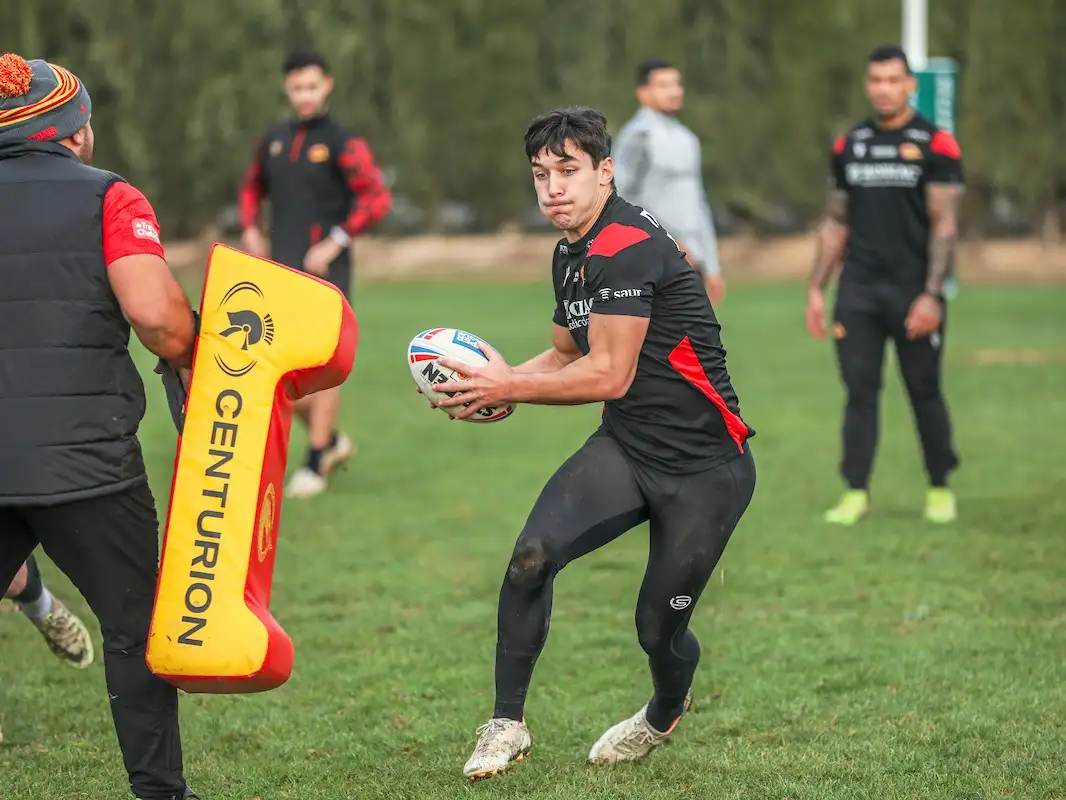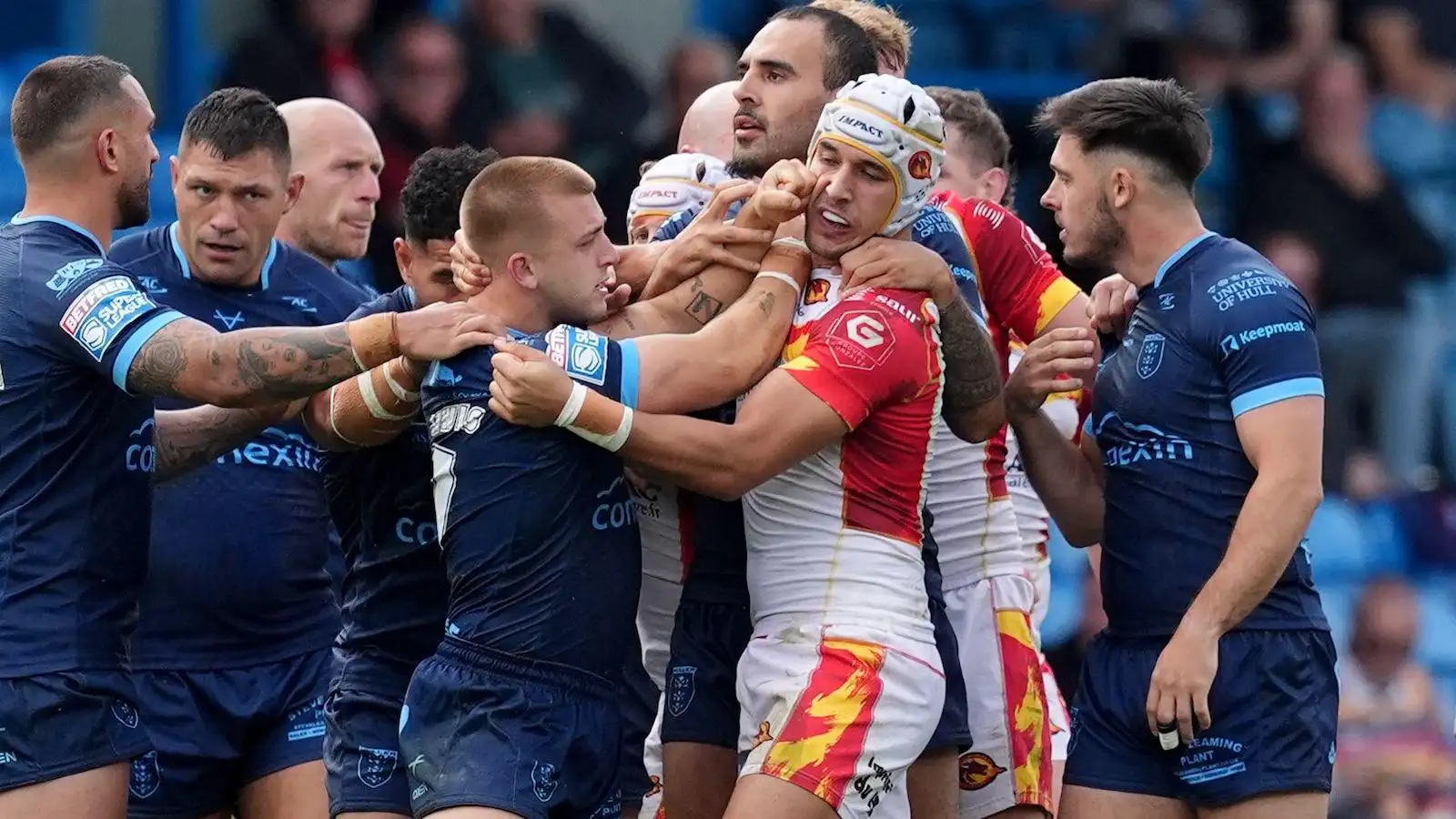Emerging talent list highlights challenges facing rugby league in the northern hemisphere

Cesar Rouge in Catalans 2023 pre-season training - Picture by Laurent Selles/Catalans Dragons/SWpix.com
When expansion is talked about, the focus is often on the big city names and locations of clubs, and rarely about players.
Players are brought in from the “heartlands” and Australia to fill up squads to ensure clubs can get to a competitive level. The same happens at international level, where the use of heritage players across all but five or six nations is high.
But one of the keys to expansion is ensuring the growth of the player pool and developing your own. It’s something that will take time, particularly to get to the level to compete with even those plying their trade in League 1.
It was a shame that recently, West Wales Raiders were forced to withdraw from the RFL professional pyramid, with some of their difficulties no doubt caused by the fact they were largely uncompetitive with local players.
Players like Joe Burke, who starred for Wales at the recent World Cup, now have nowhere feasibly local to play rugby league professionally due to the work commitments required around being a part-time player. That means they are possibly lost to the game and unable to develop further. Not so much of an issue for Burke, who is heading towards the twilight of his career, but any younger equivalents of his now have no real pathway to the professional game, at least in the short term and despite the best efforts of Wales Rugby League.
Emerging rugby league talent
Friend of Love Rugby League and international devotee Gavin Willacy recently compiled a list of the top 10 emerging talents in European rugby league.
There’s nothing wrong with the players on the list, which includes Halifax and Scotland winger Lachlan Walmsley and recent Toulouse signing Josh Ralph, who played for Wales at the World Cup.
But of these 10 emerging Europeans, seven are from Australia and one is a 32-year-old rugby union convert who has been trialling in the Super League reserve grade for the past few years.

Jamaica international Kieran Rush, born in Dewsbury and currently contracted to Huddersfield, makes up the list courtesy of his country still coming under the jurisdiction of the European Rugby League federation.
Of the Australians, at least Ralph, Walmsley and York’s Bailey Antrobus will play on these shores next season, while Greece teenager Siteni Taukamo is tipped to make it big in the NRL.
They all qualified to play at the World Cup for nations through heritage – again, nothing wrong with that in the context of modern day international sport.
But where is the true emerging, home-grown talent coming from via the player pools being created by the ever-increasing number of rugby league playing nations, as we are told by the international federations.
Only Guy Graham, a 24-year-old Scotsman who switched from rugby union two years ago, could be considered to be a player who has progressed through a genuine rugby league pathway in Europe. He featured at the World Cup for his country after becoming a regular in the Championship for Whitehaven.
More real European talent
We are all desperate to see the growth of rugby league internationally, and presently, the only way to bring certain countries in to the fold is to rely on heritage players. We still want to highlight them as players, rightly so, of their countries – but it hides what’s going on underneath.
It’s the same challenge that the likes of Serbia face when trying to qualify for the World Cup – their largely homegrown team coming up against the likes of Scotland and Ireland filled with heritage players.
The difficulty is getting them exposure to the semi-professional game from those countries. Only England and France can provide that level of competition currently, and the tightening of visa rules since Brexit make that an even greater challenge before you even consider the economic impact on clubs and players alike.
In the past we’ve seen Serb Soni Radovanovic at Whitehaven and Malta’s Roderick Attard at Gateshead try and prove themselves at Championship level, although that was more than a decade ago and is an anomaly rather than the norm.
On the Golden Boot shortlist this year was Netherlands international centre Joran Schoenmaker, a 22-year-old marketing student from Zwolle who starred in their games against Spain, Germany and a European Combined Nations side.
Described as a pacey and powerful centre, Schoenmaker has played rugby league for four years and will be hoping the Orange Lions can cause an upset in the European Championship B next year and move within one step of qualifying for the 2025 World Cup.
He has recently completed an eye-catching move to North Wales Crusaders, which could prove to be a path for others in mainland Europe to follow.
⚫️🟡2023 SIGNING🟡⚫️
DUTCH FLYER SIGNS FOR CRUSADERS
Joran Schoenmaker is Crusaders latest signing for 2023. Schoenmaker, who is a winger or centre, has been a standout in the Netherlands for a number of years, winning the 2018 NRLB with Amsterdam Cobras. pic.twitter.com/jFns7CPlUY
— North Wales Crusaders (@NWCrusaders) December 27, 2022
The talent in the French Elite Championship often goes under the radar too, despite the French presence in Super League and the Championship.
Although more players are becoming familiar, the majority of French players in the Catalans squad are still more squad players than out and out regulars and stars – something that will change in upcoming years thanks to the development work of the Dragons. Timely too, given the IMG recommendations around homegrown talent.
The scrum-cap wearing former Avignon full-back or winger Corentin Rey is trying to break through the ranks at Catalans, while half-back Cesar Rouge is likely to be France’s biggest hope over the next decade.
Young former Lezignan half-back Thomas Lacans spent time with Newcastle Thunder in the second half of last season and has now earned a move to join the French contingent at Featherstone for 2023.

His father played for Lezignan more than a decade ago and Lacans has been playing in the French rugby league system since the age of four, a true product of the game.
He now gets to ply his trade under one of the greatest half-backs of the Super League era, new Featherstone coach Sean Long.
Lacans told the club’s official website: “I’ve not been coached by Sean previously but I obviously know his reputation as a player, for me to work with a halfback of that calibre is fantastic and I’m enjoying every minute.”
The current top try scorer in the French Elite Championship is 23-year-old Avignon winger Hugo de Monte.
Emerging rugby league talent from Eastern Europe
The country with the most rugby league participants outside of the UK and France is Serbia, who have been one of the most active nations in international rugby league in recent years.
The self-proclaimed fastest growing rugby league nation moved up to eighth in the world rankings and will be determined to qualify for the 2025 World Cup.
Brexit creates a real obstacle to any Serbians being able to play in the UK, though prop Milos Calic and winger Rajko Trifunovic have played in the French Elite Championship. Rajko’s younger brother Luka is now coming through the ranks at Red Star Belgrade and is tipped to be a player to watch, having made his senior debut in 2022.
📛 Ćalić is ready for the new season, 𝐥𝐞𝐭'𝐬 𝐠𝐨 𝐫𝐞𝐝𝐬𝐬𝐬!
🚀 #TogetherStronger pic.twitter.com/vASB2EiljR— Red Star Belgrade Rugby League Club (@RedStarRL) January 10, 2023
Half-back Vojislav Dedic and hooker Vladislav Dedic are key parts of the Red Star team, with Vojislav described to be a good in-play kicker and an excellent goalkicker, who isn’t afraid to take on the line and has a hunger for defence.
Their city rivals Partizan also have a number of exciting players coming through, including Jasmic Bibic, Velibor Karanovic and Tomislav Stojiljkovic, who are coached by long-time Serbia international Stevan Stevanovic.
The Belgrade clubs have been pushing the boundaries in Serbia, helping to create at least a part semi-professional league to help develop their player pool and improve playing standards.
It will be interesting to see how Lacans and Schoenmaker get on this season, and whether that opens up the floodgates for more eligible emerging rugby league talent to make the move to the UK.
READ NEXT: A player from each of the 51 rugby league playing nations

